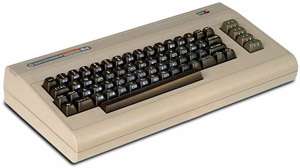Commodore 64

The Commodore 64 was the best-selling computer of all time, with 17 million sold. It was released in 1982 as a low-end computer comparable to the Apple II and the Atari 8 Bit Computers, following on their earlier VIC 20 system. It was as cheap as the Atari 2600 and is considered one of the catalysts for The Great Video Game Crash of 1983.
The system was remarkably powerful for the price. The original design was for an Arcade Game board, and the C64 therefore had unusually good color graphics, sprite support, and sound compared to its competitors. It also had an operating system contained entirely in ROM, meaning that there was close to nothing (shy of physically damaging the hardware) that could corrupt the system, making it a hacker's dream machine. There was even a windowed operating environment with desktop publishing abilities available for it (GEOS), and some code genius even figured out how to do multitasking on it. It was also home of the Quantum Link online service, operated by the company that would become AOL.
However, the success of the Commodore 64 was also its downfall. Commodore couldn't discontinue it due to high demand in Europe, and most people in North America had moved on to the Nintendo Entertainment System for their gaming needs by 1990. The C64's success also doomed every other Commodore 8-bit project, such as the MAX machine, the Educator 64, the C16, the Plus/4, the C128, the C64 Games System, and the C65.
The Commodore 64 was eventually discontinued in April 1994, when the company went bankrupt due to the now dated parts of the system being more expensive than what people paid for it. This is essentially what happens when You Fail Economics Forever happens in Real Life. However, in April 2011, Commodore announced a brand revival and is currently accepting preorders for new C64s. The new systems essentially combine the classic design with modern internals; they run the original C64 BIOS and present-day software.
Nowadays, Commodore 64 games are now being released for the Wii's Virtual Console. It's also one of the most popular platforms for the Demoscene. And a generation has learned to associate Bach's "Invention #13" with this system.
And now it's available as an app for iOS.
Your Milage May Vary page for this here.
Specifications:
- Covers Always Lie: If a game was also released for the vastly more advanced Amiga, screenshots on the box would inevitably be from that version.
- Fridge Brilliance: Computer viruses had begun to be a problem by the mid-80s. Because of its ROM-based system software and Commodore's decision to offload disk handling to the floppy drives, it was all but impossible to write a C64 virus.
- Gone Horribly Right: The computer was so popular, Commodore couldn't cancel it, even after the disk drive became more expensive to manufacture than the C64 itself.
- Keep Circulating the Tapes: the C-One computer (originally designed as a C64 clone by the self-trained Jeri Ellsworth), as well as the VICE emulator (the latter being the only way most people will ever be able to use the C65).
- Tonka Tough: The operating system was in ROM, making it virtually impossible to corrupt.
- What Could Have Been: the C65 (a few prototypes of which got out into public hands when CBM was liquidated) was a huge step forward, essentially a 16-bit C64 with added memory. Too bad Commodore had the Amiga to promote. Also, the Commodore LCD, which never made it out of a few computer magazines and one or two trade shows.
Games:
Original titles and Multi Platform games that started here:
- 4th & Inches
- Adventure Construction Set
- Barbarian: The Ultimate Warrior
- Below the Root
- Boulder Dash
- The Dizzy series
- Elvira: Mistress of the Dark
- Elvira II: The Jaws of Cerberus
- Gateway to Apshai
- Great Giana Sisters
- The Hitchhikers Guide to The Galaxy
- Impossible Mission
- Katakis
- The Last Ninja
- Legacy of the Ancients
- Lode Runner
- Maniac Mansion
- The Monty Mole series
- Reach for the Stars
- Rick Dangerous
- Sid Meier's Pirates!
- SimCity
- Skate or Die
- Spelunker
- Super Pipeline
- Test Drive
- Turrican
- Wasteland
- The Way of the Exploding Fist
- Zak McKracken and the Alien Mindbenders
Ports
- Alien Syndrome
- Alternate Reality
- Archon
- Athena
- The Bard's Tale Trilogy
- Battle Chess
- Bubble Bobble
- Buck Rogers Planet of Zoom
- Castle Wolfenstein
- Chips Challenge
- Chuckie Egg
- Crush Crumble and Chomp
- Defender
- Defender of the Crown
- Double Dragon
- Elite
- Forgotten Worlds
- Gauntlet
- Ghosts N Goblins
- Golden Axe
- Ikari Warriors
- The Legend of Kage
- Miner 2049er
- Bounty Bob Strikes Back!
- MULE
- Paperboy
- Pit-Fighter
- Popeye
- Prince of Persia
- Psycho Soldier
- River Raid
- Robotron: 2084
- Rod Land
- R-Type
- Rygar
- Shadow of the Beast
- The Simpsons
- Space Harrier
- Spy Hunter
- Star Control
- Street Fighter II
- Toki
- Track and Field
- Ultima I-VI
- Vigilante
- Wizard of Wor
- Yie Ar Kung-Fu
- Zaxxon
- Zork